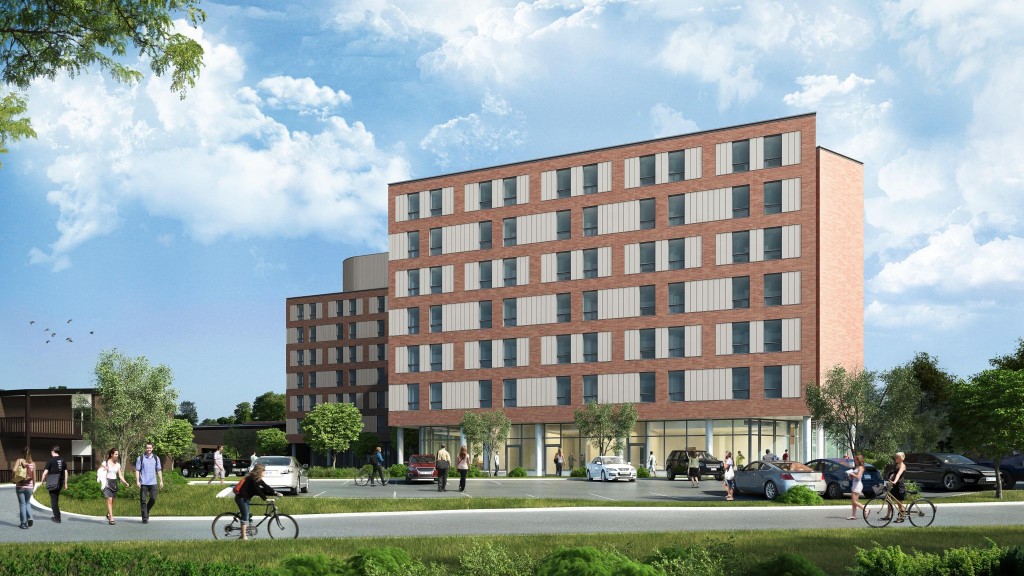St. Jerome University residence renewal

By David Dow
Last April, work on the renewal of the 150-year-old St. Jerome’s University (SJU) at University of Waterloo began. For the Southwestern Ontario project, a new collaborative design process is being used to realize the campus expansion.
The $47-million SJU campus renovation will add a seven-storey student residence and two-storey academic building, effectively doubling the built form on campus. Reconfigured roads, landscaping, and new parking will transform the existing campus and create a new gateway to the university.
Diamond Schmitt Architects, Graham Construction, and SJU are pursuing an integrated project delivery (IPD) model—one of the first examples in Canada of this design and construction process where architect, contractor, and client enter into an agreement to operate as a team.
This is a trailblazing project for all three participants and from the architect’s perspective. The IPD model emphasizes closer collaboration to optimize efficiency through all phases of design, fabrication, and construction.
By creating a three-way contractual agreement—owner, architect, and contractor—and reducing legal recourse for the signatories should the project go awry, the IPD model encourages the team to co-operate and seek mutually acceptable resolutions to design and construction problems, since profitability for all is tied to the overall project success. This ‘open-book’ process also entails lean design principals, target value design, and a high degree of team integration with collaborative use of building information modelling (BIM).
The IPD concept originated in Australia and then took hold in the United States a decade ago with many projects undertaken in California. (The first in Canada is believed to be the Moose Jaw Hospital in Saskatchewan.) While avoiding legal proceedings may act as the ‘stick,’ the ‘carrot’ is the shared profit pool, which can grow the more efficiently the project is executed. The incentive for all parties to find economies is tangible.
“Through the innovative process of IPD, St. Jerome’s University is embarking on its single biggest capital investment. The newly designed spaces will fit nicely with the university’s program and help deliver on its mission of educating the whole person,” said Darren Becks, St. Jerome’s vice-president of administration.

The project design blends the new with existing campus infrastructure and has an emphasis on open space, courtyards, and covered walkways. The desire to extend and augment the existing community has been at the heart of the project’s development.
The 2087-m2 (22,464-sf) academic building is organized around a central atrium. Opening off the atrium on two floors are various flexible classroom configurations and a raked-seat room for 300 people.
With extensive glazing at its entrance, the building provides a welcoming, student-focused point of entry that serves as a new campus gateway. The residence building comprises 360 student beds arranged in two clusters of 30 beds on six floors, with two residence supervisor rooms per floor. The ground floor has physical recreation amenities as well as study, games, and music rooms. The building shape creates two new courtyards similar in scale to the existing central courtyard that defines the heart of the campus.
The IPD model has a more intensive upfront design schedule where marathon meetings can involve upward of 20 participants, including consultants and construction sub-trade representatives, but it allows for a shortened construction schedule. Completion of both buildings is slated for next January.
 David Dow is a principal at Diamond Schmitt Architects. He manages a wide range of institutional, healthcare, commercial, recreational, and residential projects. Dow’s previous work includes Corus Quay, the Computer Science and Engineering Building at the University of Michigan, and the Bahen Centre for Information Technology at the University of Toronto. He can be contacted by e-mail ddow@dsai.ca.
David Dow is a principal at Diamond Schmitt Architects. He manages a wide range of institutional, healthcare, commercial, recreational, and residential projects. Dow’s previous work includes Corus Quay, the Computer Science and Engineering Building at the University of Michigan, and the Bahen Centre for Information Technology at the University of Toronto. He can be contacted by e-mail ddow@dsai.ca.







